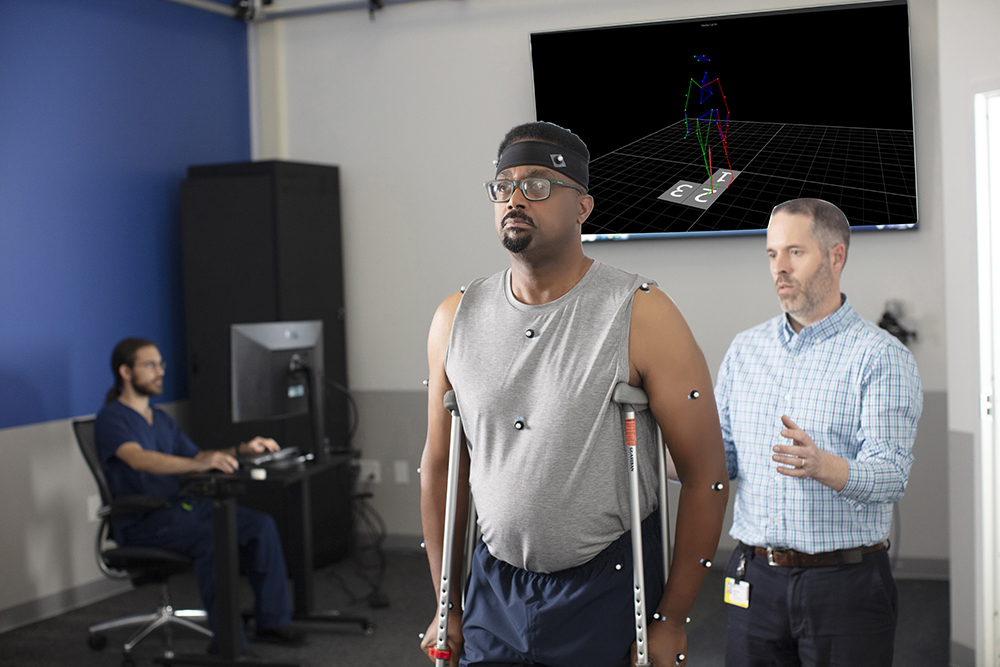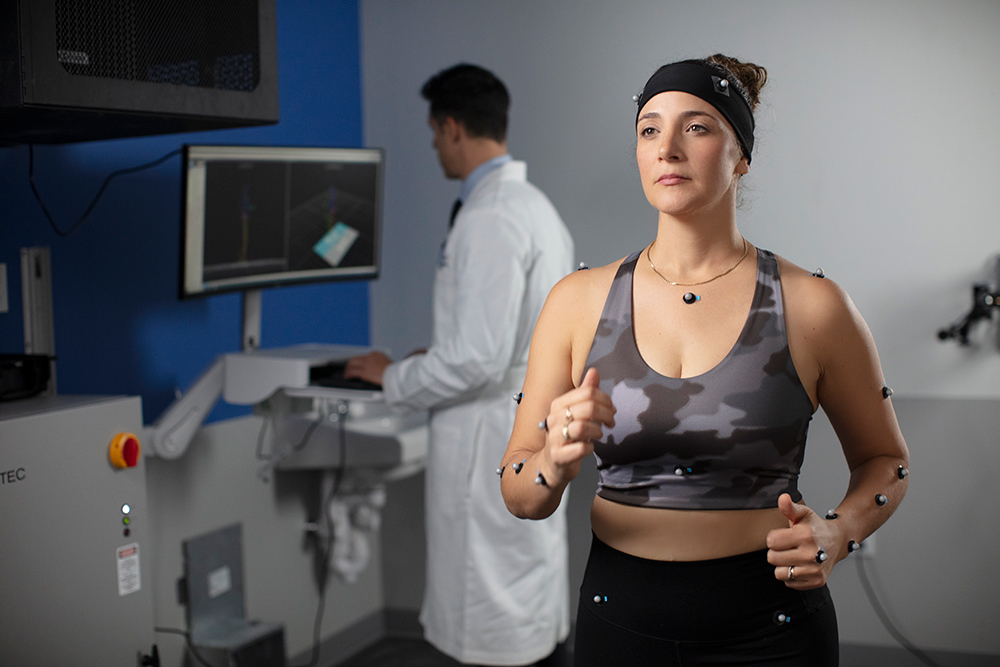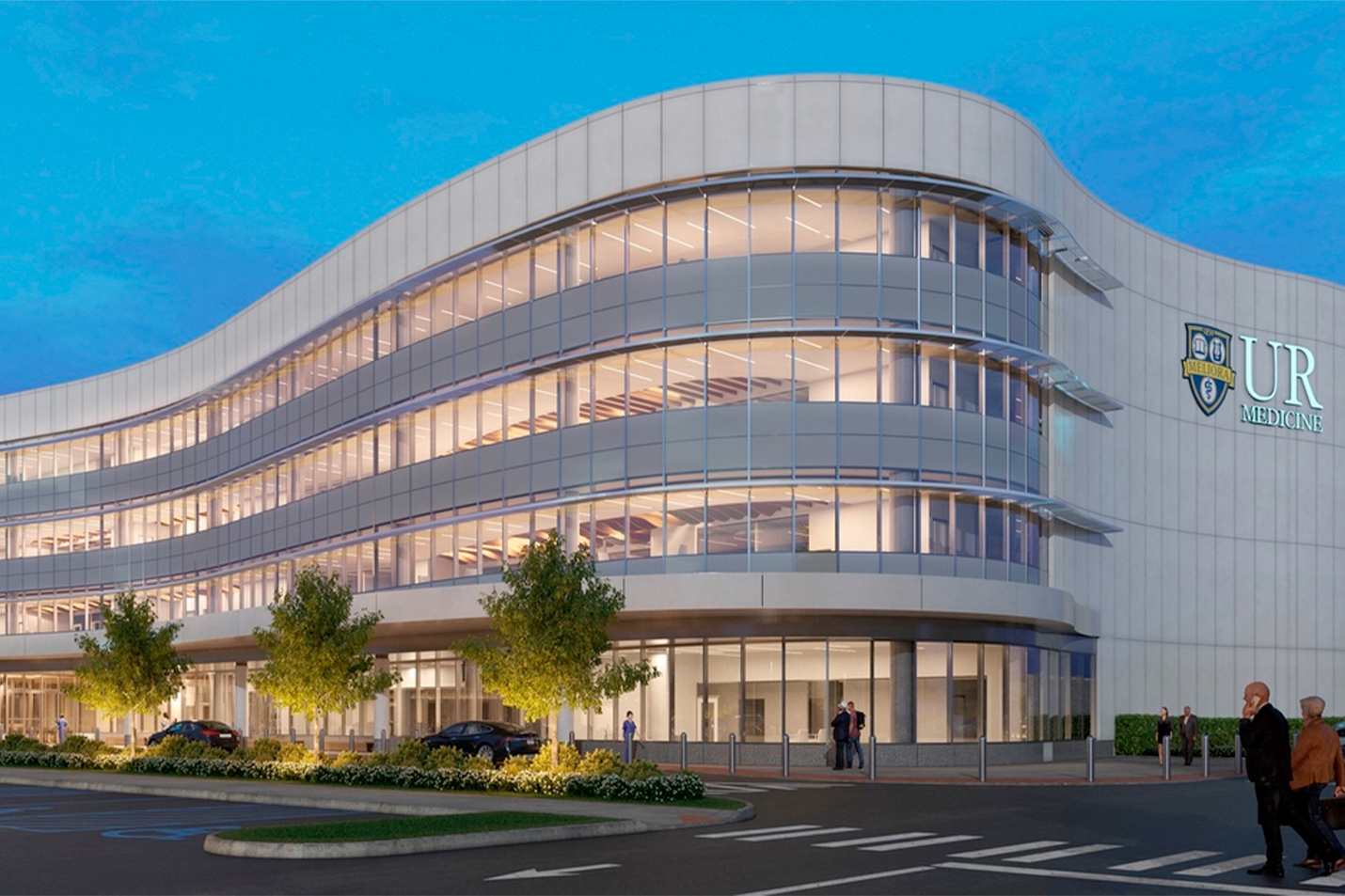Motion Labs
Make Appointments & Get Care
Overview
UR Medicine Motion Labs comprises five dedicated motion analysis rooms. We harness the collective expertise of a diverse team of physicians, therapists, Motion Lab Engineers, and exercise physiologists. Using state-of-the-art computer and sensor technology, we study, analyze, and enhance human motion. We equipped our laboratory with a range of advanced tools:
- Marker and markerless 3D motion capture systems (Vicon/Theia)
- Force platforms (Bertec)
- Force plate instrumented treadmill (Bertec)
- Electromyography systems (EMG) (Delsys)
- Electroencephalogram system (EEG) (Zeto)
- Computerized dynamic Posturography system (Bertec)
- Wearable metabolic system (Cosmed)
UR Medicine's Approach
UR Medicine Motion Labs offers two distinct focuses, catering to two unique patient groups, with the expertise of our dedicated team.
Focus 1 - Clinical Track
Serves patients with movement disorders or underlying medical conditions impacting their ability to walk or balance. Referrals guide these patients to us for gait analysis, which then informs decisions about therapeutic or surgical interventions. This analysis helps determine the need for braces or prosthetic devices to address movement challenges. We assist patients with a range of neuromuscular or musculoskeletal conditions, including:
 Patient being observed during a gait analysis.Cerebral palsy
Patient being observed during a gait analysis.Cerebral palsy- Brain or spinal cord injury
- Muscular dystrophies
- Spina bifida
- Stroke
- Amputation
- Hip/Knee/Ankle joint disorders
- Club foot and other foot deformities
- Balance disorders
- Other neurological disorders
Focus 2 - Physical Performance Track
 Patient running on test track in virtual reality lab. The UR Medicine Motion Lab’s Physical Performance Track serves athletes and active individuals with injuries or issues related to athletic performance or specific functions, such as running or throwing. Our comprehensive suite of functional and diagnostic assessments aids physical therapists and sports medicine physicians in shaping effective training and recovery plans.
Patient running on test track in virtual reality lab. The UR Medicine Motion Lab’s Physical Performance Track serves athletes and active individuals with injuries or issues related to athletic performance or specific functions, such as running or throwing. Our comprehensive suite of functional and diagnostic assessments aids physical therapists and sports medicine physicians in shaping effective training and recovery plans.
For information about our services, our expert team of providers, the referral process, and more, please visit the Physical Performance Track section.
Providers
- Director: Ram Haddas, PhD, MBA
- Lab Manager: Josh Tome
- Motion Lab Engineering Tech: Jose Corredor
- Physical Therapists:
- Patrick Barber – Shoulder
- Theresa Barry – Knee
- Elisabeth Campbell – Spine
- Kate Corrado – Concussion
- Tyler Murray – Hip
- Jillian Santer - Running and Foot and Ankle
What Sets Us Apart?
The team at UR Medicine’s Motion Labs comprises technicians, physical therapists, and physicians. These professionals are not only specially trained in 3D Motion Analysis but are also experts in the study of human movement.

Image: We can help patients restore AND enhance function: whether they are recovering from injury or managing a chronic disease, or want to improve their fitness and maximize their physical performance.
Locations
We serve you in the Rochester metropolitan area and surrounding region.
1 location
Marketplace
10 Miracle Mile Drive
Rochester, NY 14623
Patient Education & Support
Clinical Track Information
Gait abnormalities are deviations in regular walking patterns, often stemming from disease or injury. These irregularities can lead to pain in the hips, back, neck, feet, knees, and ankles. Gait analysis, commonly referred to as walking or motion analysis, offers an in-depth evaluation of an individual’s posture and walking patterns. This analysis can help:
- Pinpoint underlying muscle, nerve, or skeletal issues.
- Identify the root cause of a patient's pain while standing or walking.
- Help to diagnose bone deformities or skeletal misalignments.
- Uncover potential muscle or nerve dysfunction.
- Monitor the progression of diseases like arthritis or muscular dystrophy.
Gait analysis is a non-invasive diagnostic method that plays a pivotal role in detecting specific medical conditions, determining the need for additional testing, and highlighting potential treatment paths.
Types of Gait Analysis
While we can conduct gait analysis through basic observation, modern technology has revolutionized the process. By analyzing the data provided by several devices, professionals can now evaluate a patient’s gait and parameters such as step length, stride length, cadence, cycle time, and joint angles. In clinical gait analysis, practitioners employ several methods, including:
- Video-based Analysis: Cameras capture the patient's movement from different angles, enabling a comprehensive view of walking patterns.
- Force Plates: These measure the forces exerted by the feet during walking, giving insights into weight distribution and balance.
- Electromyography (EMG): By measuring electrical activity, EMG provides information on muscle activation patterns during gait.
- Inertial Sensors: These devices, often attached to the patient, capture movement data in real-time, allowing for detailed analysis of various gait aspects.
- 3D Motion Capture Systems: Using markers placed on the patient, these systems offer a three-dimensional view of gait mechanics.
Our motion analysis experts work closely with the patient’s medical team. Together, they thoroughly examine all aspects influencing the patient’s movement patterns. This collective effort informs appropriate surgical procedures or treatments to enhance function and comfort.
What to Expect from Gait Analysis
Purpose: Gait analysis evaluates how the body moves, typically when walking or running. The goal is to identify irregularities in your motion.
Complexity: An individual’s gait is a unique function that utilizes the body’s visual, somatosensory, and vestibular systems. Disruptions or issues with these systems, or problems with the associated joints, can result in abnormalities in gait or posture.
Duration: Lasts between 2 to 4 hours.
Appointment Preparation Guidelines
- Arrive 15 minutes before your appointment. Use the Fitness Science entrance.
- Bring or wear clothing that will allow you to move freely.
- Wear tank tops and shorts to allow visualization of your knees and shoulders.
- Wear sneakers or running shoes.
- Bring any braces, foot orthotics, and walking aids (crutches, walkers, canes) that you use for daily function.
During the Appointment
The motion test includes two components:
- A series of questionnaires to help understand your range of motion.
- Recording your movement using a combination of cameras, markers placed on your skin, and force plates.
Once inside the lab, you will be asked to perform a series of actions. The actions are meant to be performed within your comfort and capability.
The motion test will include:
- Placement of Markers & Sensors: Once back in the exam room, the physical therapist will affix small reflective markers and sensors to your body using tape. The cameras capture the movement of these markers, while the sensors detect the activation and relaxation of your muscles.
- Walking Assessment: You'll be instructed to walk back and forth across the room, covering a distance of about 15-20 feet multiple times. This allows the cameras to record your gait. Should you feel fatigued, the physical therapist will offer you breaks to rest.
- Conclusion of Analysis: Once the walking assessment is complete, the physical therapist will carefully remove all markers and sensors. You can then change back into your regular attire.
- Additional Steps: Before concluding the appointment, there might be a request for you to undergo an X-ray. This is particularly true if the doctor desires detailed images of the bones in your feet or legs. During your subsequent visit, your doctor will review and discuss the results of the motion analysis with you.
Physical Performance Track
Top-tier athletes consistently push their limits while ensuring they perform efficiently and safely. At UR Medicine Motion Labs, our Physical Performance team specializes in sports performance motion analysis. Whether you're an athlete aiming to recover from an injury, striving to lower your injury risk, or looking to elevate your game, we employ the same biomechanical principles and state-of-the-art tools to serve athletes at every skill level.
Our Focus Areas Include:
- Recovery from sports-related injuries
- Specialized analysis for running, lower extremity activities, throwing, ACL concerns, and concussion evaluations
- Performance optimization for elite athletes
Our motion analysis goes beyond surface-level observation. By harnessing advanced 2D video techniques, 3D motion capture, force plates, and surface EMG sensors, we get a comprehensive view of athletes' sport-specific movements. We delve deep, analyzing the kinematic, kinetic, and electromyographical aspects of performance.
From Injury Recovery to Peak Performance
Our tools enable us to visualize issues under the skin, allowing for the identification and rectification of potential problems before they escalate into injuries. If you've sustained an injury, think of us as your bridge—from healing through physical therapy to your triumphant return to the field. Moreover, doctors frequently direct their patients to our lab to gauge their readiness for re-entry into sports.
Post-analysis Follow-up
Once our in-depth analysis concludes, our team crafts strategies to mitigate the risk of future sports-related injuries and bolster efficiency in sports movements. Every athlete is unique, and our data-driven insights are tailored to individual athletes, guiding them toward their performance goals.
What to Expect During Your Visit
Appointment Preparation Guidelines
- Arrive 15 minutes before your appointment. Use the Fitness Science entrance.
- Bring or wear clothing that will allow you to move freely.
- Wear tank tops and shorts to allow visualization of your knees and shoulders.
- Wear sneakers or running shoes.
- Bring any braces, foot orthotics, and walking aids (crutches, walkers, canes) that you use for daily function.
During the Appointment
The motion test includes two components:
- A series of questionnaires to help understand your range of motion.
- Recording your movement using a combination of cameras, markers placed on your skin, and force plates.
Once inside the lab, you will be asked to perform a series of actions. The actions are meant to be performed within your comfort and capability.
The motion test will include:
- An initial physical therapy assessment to evaluate your strength and range of motion.
- A few moments to change into Spandex shorts, a shirt, and a headband, all of which we provide in various sizes. These garments come equipped with reflective markers strategically placed on the head, torso, arms, and legs.
- A warm-up session, involving either jogging or walking, based on preference and comfort.
- A recorded testing phase where you'll be guided through a series of escalating, sport-centric movements.
Additional Resources
To get to your appointment, you should go to the Fitness Science entrance of the The Saunders Center for Orthopaedics and Physical Performance. Please arrive at least 15 minutes before the appointment time. If you are late, you may need to reschedule. Check in with the front desk staff and let them know that you are here for a Motion Labs assessment. The front desk staff will notify an attendant who will take you to the Motion Labs. The assessment will take place in two parts and will take approximately 2-3 hours.
